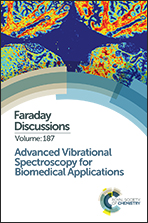Vibrational spectroscopy in sensing radiobiological effects: analyses of targeted and non-targeted effects in human keratinocytes†
Abstract
Modern models of radiobiological effects include mechanisms of damage initiation, sensing and repair, for those cells that directly absorb ionizing radiation as well as those that experience molecular signals from directly irradiated cells. In the former case, the effects are termed targeted effects while, in the latter, non-targeted effects. It has emerged that phenomena occur at low doses below 1 Gy in directly irradiated cells that are associated with cell-cycle-dependent mechanisms of DNA damage sensing and repair. Likewise in non-targeted bystander-irradiated cells the effect saturates at 0.5 Gy. Both effects at these doses challenge the limits of detection of vibrational spectroscopy. In this paper, a study of the sensing of both targeted and non-targeted effects in HaCaT human keratinocytes irradiated with gamma ray photons is conducted with vibrational spectroscopy. In the case of directly irradiated cells, it is shown that the HaCaT cell line does exhibit both hyperradiosensitivity and increased radioresistance at low doses, a transition between the two effects occurring at a dose of 200 mGy, and that cell survival and other physiological effects as a function of dose follow the induced repair model. Both Raman and FTIR signatures are shown to follow a similar model, suggesting that the spectra include signatures of DNA damage sensing and repair. In bystander-irradiated cells, pro- and anti-apoptotic signalling and mechanisms of ROS damage were inhibited in the mitogen-activated protein kinase (MAPK) transduction pathway. It is shown that Raman spectral profiles of bystander-irradiated cells are correlated with markers of bystander signalling and molecular transduction. This work demonstrates for the first time that both targeted and non-targeted effects of ionizing radiation damage are detected by vibrational spectroscopy in vitro.
- This article is part of the themed collection: Advanced Vibrational Spectroscopy for Biomedical Applications


 Please wait while we load your content...
Please wait while we load your content...